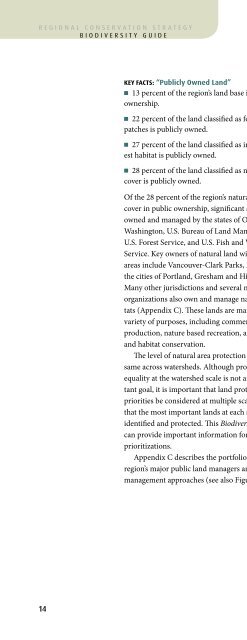Biodiversity Guide - The Intertwine
Biodiversity Guide - The Intertwine
Biodiversity Guide - The Intertwine
You also want an ePaper? Increase the reach of your titles
YUMPU automatically turns print PDFs into web optimized ePapers that Google loves.
egional conservation strategybiodiversity guideKey Facts: “Publicly Owned Land”n 13 percent of the region’s land base is in publicownership.n 22 percent of the land classified as forestpatches is publicly owned.n 27 percent of the land classified as interior foresthabitat is publicly owned.n 28 percent of the land classified as natural landcover is publicly owned.Of the 28 percent of the region’s natural landcover in public ownership, significant acreage isowned and managed by the states of Oregon andWashington, U.S. Bureau of Land Management,U.S. Forest Service, and U.S. Fish and WildlifeService. Key owners of natural land within urbanareas include Vancouver-Clark Parks, Metro, andthe cities of Portland, Gresham and Hillsboro.Many other jurisdictions and several nonprofitorganizations also own and manage natural habitats(Appendix C). <strong>The</strong>se lands are managed for avariety of purposes, including commercial forestproduction, nature based recreation, and speciesand habitat conservation.<strong>The</strong> level of natural area protection is not thesame across watersheds. Although protectionequality at the watershed scale is not an importantgoal, it is important that land protectionpriorities be considered at multiple scales, andthat the most important lands at each scale beidentified and protected. This <strong>Biodiversity</strong> <strong>Guide</strong>can provide important information for suchprioritizations.Appendix C describes the portfolios of theregion’s major public land managers and theirmanagement approaches (see also Figure A-6).For More InformationFinal Report on Land Cover Mapping Methods,Map Zones 2 and 7, PNW ReGAPE.B. Grossmann, J.S. Kagan, J.A. Ohmann, H.May, M.J. Gregory, C. Tobalske. 2008. Institutefor Natural Resources, Oregon State University,Corvallis, OR.“Actual Vegetation Layer”D.M. Stoms. 1994. A Handbook for Gap Analysis.“Assessing Land Cover Map Accuracy for GapAnalysis”D. Stoms, F. Davis, C. Cogan, and K. Cassidy.1994. A Handbook for Gap Analysis.How Can My Watershed Address Help Me FindUSGS Data? (And What Is a HUC?)http://nwis.waterdata.usgs.gov/tutorial/huc_def.html14




